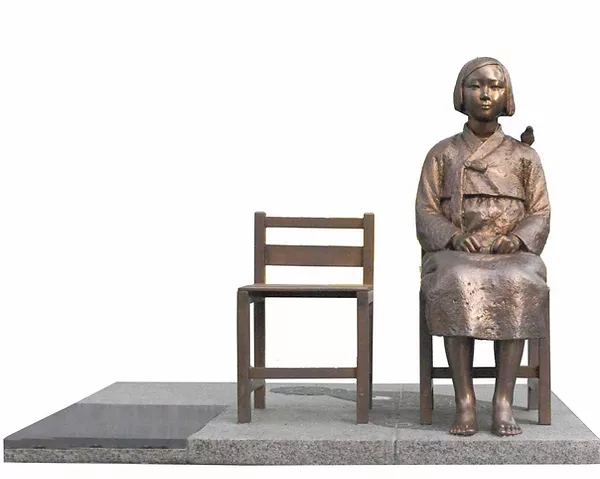If you see this after your page is loaded completely, leafletJS files are missing.
By Soojin Rhyu-Han from Punggyeong World Cultures e.V.
_ _ _ _
On 19.02.2020 the vernissage of the exhibition “Girl Statue for Peace” took place at Goethe University. The sculpture commemorates hundreds of thousands of girls and young women affected by sex slavery during World War II. It is now found not only in Korea, its country of origin, but also in the USA, China, Canada and Australia.

From Feb. 17 through July 16, 2021, the statue was to be displayed in the lobby of the PEG building on the IG Farben campus. It was then extended until January 2021 due to the Corona pandemic.
We know that the Axis powers of World War II consisted of Germany, Italy and Japan. But to what extent do we know what these forces have directed in the territories and colonies they occupied? The crimes of Nazi Germany in occupied Poland, for example, are documented in the IG-Farben Haus, among other places. But there are also efforts in Frankfurt to commemorate the systematic crimes of Japanese militarism during World War II, for example, the Verskavten known as “comfort women.”
“Comfort woman” is a euphemism for systematic sex slavery created and controlled by the Japanese army from 1932 to 1945. Through the use of violence, kidnapping, and false promises of paid labor, the Japanese military forced hundreds of thousands of women and children, including girls as young as 12, into sex slavery. Because of the geographic reach of the Japanese empire, the nationalities of the victims were diverse, including Korea (not then divided in two), China, Taiwan, the Philippines, Indonesia, Malaysia, Burma, Thailand, Vietnam, and East Timor-but also from countries with military and civilian presence in those regions, such as the Netherlands, Germany, France, the United Kingdom and the United States. It was a deliberate part of military strategy and aggression to stimulate the fighting spirit of soldiers and prevent venereal disease. Among other things, the Japanese state had “recruited” young girls from Korea because it was assumed that girls who had not previously engaged in prostitution and were not yet married would not carry STDs into the army. This made sex slavery a better alternative for the Japanese state compared to private brothels that existed in many ports before wartime.
To this day, the Japanese government refuses to acknowledge official responsibility for the systematic violence.
The extremity and brutality of violent acts committed in the rape centers exceed any human imagination. Survivors’ testimonies bear witness to the horrific scale of atrocities when war, militarism, and fascism intersect with colonialism and sexual exploitation. They admonish to this day about their danger and inhumanity.
The reaction of the Japanese Embassy, as well as quite a few right-wing civil groups who consider the erection of the statue a violation of Japanese state interests and demand its removal, show that such a commemoration is in itself an act of strong political significance.
~
Sources and literature:
Punggyeong Weltkulturen e.V. – Website www.punggyeong.org
Frankfurter Rundschau (Hannes B. Mosler, 03/27/2022): Japan’s Endless Closing Policy
